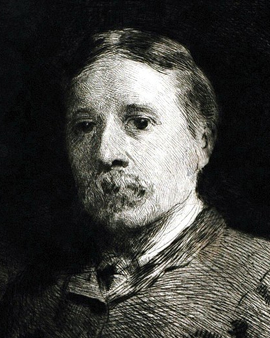


Heywood Hardy was a British painter who was especially appreciated for his animal paintings and hunting scenes. He was the youngest of 10 children of the renowned landscape painter James Hardy Senior. Many of his siblings and cousins also became famous artists. So it was to be expected that the youngest scion of the family also became interested in art. At the age of 17 Heywood Hardy left his parents' house after a dispute with his father and moved to the vicinity of Bristol. There he started painting and sold some of his first works. At the age of 22 he was allowed to exhibit at the Royal Academy for the first time. By this time he had finally saved up enough money to move to Paris and study at the École des Beaux-Art. There he was mainly taught by Isidore Pils.
Hardy's passion for art was great. He spent most of his free time in Paris copying the paintings in the Louvre. After living and studying in Paris for several years, the young artist moved back to England after a short detour via Antwerp. From 1870 he lived in London and shared a studio with the British painter Briton Riviére. From then on Hardy devoted himself almost exclusively to animal painting. It was especially important to him to study the anatomy and movements of his objects exactly. For this purpose Hardy made several trips to Egypt to observe and paint animals in the wild. His second preferred place of study was the London Zoo. He also took lessons in comparative anatomy with a professor of zoology. Hardy even painted the illustrations for the professor's study on the gait of horses. When a lioness died at the London Zoo, Hardy used the opportunity to acquire the dead animal and have it prepared for him.
In his later works Hardy increasingly turned to hunting scenes in his art or painted portraits of his clients while riding and in nature. He was a much sought-after painter who was often invited to the estates of his patrons to paint them or their beloved animals. Hardy was not actually an Impressionist painter, but belonged more to the Victorian era, but his style showed some similarity to this art movement. This is probably due to the fact that he was in Paris at the very time when Impressionism was at its height there. At the age of 83, a new turn in Hardy's art came. He moved to Sussex and painted religious motifs and altarpieces. Some of his latest works depicted Christ walking through the Sussex countryside or in the company of local personalities. Hardy was married to Mary Beechy. The couple had four daughters, two of whom also became successful artists.

Heywood Hardy was a British painter who was especially appreciated for his animal paintings and hunting scenes. He was the youngest of 10 children of the renowned landscape painter James Hardy Senior. Many of his siblings and cousins also became famous artists. So it was to be expected that the youngest scion of the family also became interested in art. At the age of 17 Heywood Hardy left his parents' house after a dispute with his father and moved to the vicinity of Bristol. There he started painting and sold some of his first works. At the age of 22 he was allowed to exhibit at the Royal Academy for the first time. By this time he had finally saved up enough money to move to Paris and study at the École des Beaux-Art. There he was mainly taught by Isidore Pils.
Hardy's passion for art was great. He spent most of his free time in Paris copying the paintings in the Louvre. After living and studying in Paris for several years, the young artist moved back to England after a short detour via Antwerp. From 1870 he lived in London and shared a studio with the British painter Briton Riviére. From then on Hardy devoted himself almost exclusively to animal painting. It was especially important to him to study the anatomy and movements of his objects exactly. For this purpose Hardy made several trips to Egypt to observe and paint animals in the wild. His second preferred place of study was the London Zoo. He also took lessons in comparative anatomy with a professor of zoology. Hardy even painted the illustrations for the professor's study on the gait of horses. When a lioness died at the London Zoo, Hardy used the opportunity to acquire the dead animal and have it prepared for him.
In his later works Hardy increasingly turned to hunting scenes in his art or painted portraits of his clients while riding and in nature. He was a much sought-after painter who was often invited to the estates of his patrons to paint them or their beloved animals. Hardy was not actually an Impressionist painter, but belonged more to the Victorian era, but his style showed some similarity to this art movement. This is probably due to the fact that he was in Paris at the very time when Impressionism was at its height there. At the age of 83, a new turn in Hardy's art came. He moved to Sussex and painted religious motifs and altarpieces. Some of his latest works depicted Christ walking through the Sussex countryside or in the company of local personalities. Hardy was married to Mary Beechy. The couple had four daughters, two of whom also became successful artists.
Page 1 / 1






